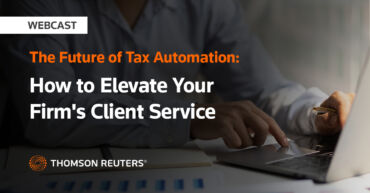Whether you’re looking to branch out and start your own firm, or you’re a current small firm owner, the idea of continuing to evolve and design your tax and accounting firm is a constant in your mind.
In this next chapter of Small Talk with Heather Walker, I am once again joined by Paul Miller, Founder and Owner of Business by Design. Together, we discuss how Paul embraced a growth mindset in creating his own business, and how you can bring advisory processes into the foundation of your firm.
From a growth mindset to a business ‘by design’
Paul Miller’s path into tax and accounting started different than most because it didn’t start in the industry.
“I started in the world of self-employment,” explains Paul. “I knew nothing about taxes, so I would ask people what I needed to do about my taxes, and people would tell me to find a good accountant.
“At that time though, I was selling financial products that had certain tax implications, so I was curious about it. When I would talk to accountants, what I found unusual is I would ask questions about setting myself up correctly and things I should be doing, and they would reply, ‘I can only do this tax return. We can only do this financial statement.’ Everyone kept telling me what they could do in the past.”
Frustrated by the historical thinking of his accountants, Paul went on a path of figuring things out on his own.
“I would go to bookstores or libraries and learned about taxes. For the first couple years of being self-employed, I figured it out on my own. I kept running across other entrepreneurs like me that were on a 1099 basis and had the same issues. I realized there was a communication gap. People were asking for help with taxes, and the accounting industry was providing historical stuff. But the business owner is saying they don’t really care about that. I really want to know what I need to do so I don’t get into problems.”
Paul realized the need for a service developed around this sort of thinking. At Business by Design, which now works with about 700 small business entrepreneurs mostly in the metro area of Minneapolis, they started focusing less on the tax return, and more on understanding the business model.
“What I started learning in the first 10 years or so working in tax and accounting was all my competitors were historical thinking, and no one was really teaching people method and process. What entrepreneurs want, and have been spending decades asking for, is someone to predict the future.”
Putting the advisory process into motion
Utilizing his growth mindset, Paul started developing an advisory process early on in his business. Now, for over 25 years, he’s in the business of predicting the future.
“What we need to learn in the word of tax and accounting is that the technical stuff, it’s assumed we know it,” says Paul. “What people really want to know is, how do I avoid the issues? What are the things I don’t know? What are the questions I should be asking? That’s where the real value component lies.”
Paul’s clientele does not typically have a CFO, so they rely heavily on the accountant relationship. And in the world of tax and accounting, we feel pressures of deadlines, not allowing a lot of bandwidth for developing future opportunities or relationships.
“I’ve never seen more things put on the plate of accountants,” adds Paul. “It’s amazing to me because when I first started doing this, I felt like I might have a 5-year run until I run out of resources. How many small businesses can there be? What has blown me away is the need has grown, and it’s now less about the transactions and more about the education, the training, and predicting the future.”
However, where a lot of accountants struggle with this advisory process is the pricing model.
“Everyone wonders, what do you charge,” says Paul. “My standard answer is, how much is a bag of groceries? They can’t answer, there are too many factors. We feel the instinct that we need to give a number. We need to deviate away from that and get more into the habit of saying, you come to work with Business by Design, you’re going to buy a relationship.
“Once we start moving into this mindset, we start changing the value proposition that we have. One thing I’ve learned is that, different parts of my brain are priced differently. We hold the keys to the kingdom in a sense that we have a scarcity of knowledge and can control how we price out that scarcity. Firms can position themselves to say, I want to do something different, what can we do to evolve these relationships in a different way?”
The biggest hurdle for accountants is themselves
There is a clear benefit to implementing a growth mindset and involving advisory services when building your firm. However, many accountants, both those starting their own business and those looking to expand, are holding themselves back from making the shift.
“We all fall victim to our skill set,” says Paul. “The major thing that an accountant is wired to be is right. You’re judged on always having to be right. So, what happens is, when you try to predict the future, it’s not always about being right. It can be super overwhelming, psychologically, for people that have always done it a certain way to break free of.
“What’s happening right now, even in the past 24 months, is our job description is completely different. Clients don’t care about the compliance work as much anymore. I think the biggest hurdle for most accountants is themselves. We need to ask more questions and do more listening. The technical stuff we do is still super important, but most clients are going to ask for strategy and thought process. We say our job is to understand what levers to pull, when to pull them, and how far to pull them. I’ve never seen an environment as we’re in right now where there are as many choices. It’s so confusing for the average person. A tax return is a tax return. We have to break out of that mindset and believe that we bring a certain set of value.”
The reality is, you’re not going to be 100% right all the time. You must be flexible, navigate, and be timely.
“I bet a strong 80% of our bandwidth is tied up doing compliance,” adds Paul. “Fast forward a couple of years, what a waste! Here you have these brilliant minds, this human capital, willing to do a lot of things, and we’re trying to make sure a form is processed or mailed. It’s not smart.”
Designing your firm’s future
Maybe you’re reading this and feeling the motivation to kick off your own firm’s growth journey, but you’re confused as to where to start.
“Someone may be working at a firm and wanting to go off on their own, or a smaller firm may be trying to understand what they need to do to grow,” says Paul. “There’s going to be a clear separator between personal service businesses and just trying to be as profitable as possible.
“I think what happens when people decide to do their own thing, the first thing they want to do is just be busy. Most people do not need to be busier. It’s about being very intentional with who you want to work with, what you need to do, and what services you provide. You need to do some research and development, but don’t over complicate it. Start with the simple things. I think you’ll find that some things are highly duplicable. The first 1 or 2 times you do it, you may not be as profitable. But once you do it the 10th or 20th time, you can start reaping the benefits of profitability.”











